
Answer [1]: The iron that makes up the core contains a large number of "magnetic domains", i.e., small volumes that are themselves magnetized so they act like little magnets. Normally, these domains are orientated randomly as shown below:

If they are random then overall the core is not magnetized since the effects of the individual "magnets" cancel out. When placed in a coil that carries a current, however, these domains tend to "line-up" because the magnetic field due to the coil applies a torque on each domain. When the domains in the core line up it acts like a large magnet. So, the number of lines of magnetic field, equal to those produced by the coil itself plus the magnetized core, is greatly increased. As a result the magnetic induction is greatly increased also.
Answer [2]: Faraday's Law gives us the reason; the alternating magnetic field induces an emf in the ring that also alternates. Since the ring is a conductor, i.e., it has a relatively small resistance, a large alternating current will be induced in the ring also. (These currents are called "eddy currents".) At any instant, the power produced is (voltage × current), which may be large, large enough to cause a heating effect. Note that if the magnetic field is constant there will be no heating effect because there will be no induced emf and no current.
This type of heating - "eddy current" or "induction heating - is used on some stovetops. Beneath the stovetop, which is usually some easily-cleaned, ceramic material, there is a coil that carries a rapidly alternating current. This coil produces a rapidly alternating magnetic field, and when a metal saucepan is placed on the coil then the alternating field induces an alternating emf in the bottom of the saucepan. The emf produces a current and so heating occurs. Note that this is not a "hotplate" because it's not hot; the surface of the stovetop can be quite cold since the heating effect is produced in the saucepan itself!
Will it work with all saucepans? No! The saucepan must be made from a conducting material; the effect works with most metal pans but it will not work with ceramic or pyrex pans.
Answer [3]: The second wire is twice as long as the first and so it has twice the resistance. Although the emf induced in the second wire is twice that in the first wire, the fact that the resistance is twice as large means that the current is the same ... Ohm's Law.
Answer [4]: Your friend is correct in saying that a higher voltage across a particular load will produce a higher current. Where your friend is confused is that transmission lines from a power station deliver power. Since a power station delivers power it means that (voltage × current) is constant, i.e., any increase in voltage will necessary mean a decrease in current, and vice versa. In normal transmission lines, the voltage from the power station, at maybe 25,000V or less, is stepped up by a transformer, maybe to 750,000V or more, so the current is correspondingly reduced. Since the losses through heating in the transmission lines is I2R, where R is the resistance of the transmission line, the losses are therefore smaller if the current is smaller. To get the voltage to the value required for home use, i.e., 110V, step down transformers are located near to our homes.
Answer [5]: The magnet induces currents in the copper pipe as it falls because, at any point in the pipe, there is a change in magnetic flux. By Faraday's Law this induces and emf, and hence a current that, by Lenz's Law, opposes the motion. So as the magnet falls vertically, the change in flux below the falling magnet produces a repulsive force, i.e., an upward force (opposite to gravity), and the change in flux above the falling magnet produces an attractive force, i.e., an upward force also (opposite to gravity). The magnitude of these upward forces depends on the speed of the magnet, the faster the magnet falls the greater the upward force. When the upward force equals the weight of the magnet, the latter will reach its terminal velocity (since there will be no net force acting on it). With a plastic pipe, an emf is generated, but since plastic is an insulator, there will be no currents and so there will be no upward forces.

The figure shows the direction of the currents induced in the copper tube, assuming the magnet falls N end first. Also shown are the directions of the magnetic field lines for the magnet and the induced currents. A similar picture occurs for a magnet falling S end first, except the induced currents and the induced magnetic fields are reversed.
Answer [6]: Magnetic field lines close on themselves, i.e., they do not just "stop". Therefore, any line of flux passing into the sphere will also exit the sphere. Thus, the net flux is zero. In fact, the net flux equal to zero is true for any closed surface. Note, that is NOT necessarily the case for electrical charges; remember Gauss's Law?
Answer [7]: The current carrying wire produces a magnetic field that, by the right hand rule, is directed downward through the loop, i.e., into the page. Also, the magnetic field is not constant; it is greatest close to the wire and it decreases in magnitude away from the wire. Consequently, when the loop is pushed towards the wire there is a change in flux through the wire, in fact, the flux increases. By Lenz's Law, to counteract this increase in flux a current will be induced in the loop to create a counteracting magnetic flux through the loop, i.e., out of the page. By the right hand rule the induced current must be counterclockwise. In fact, the loop doesn't have to be rectangular; the result is same even if it's circular, etc.
There is another way of looking at this problem (of course!); consider the currents induced in the segments AB, BC, CD, DA.
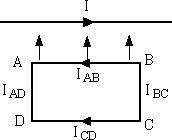
Since the velocity vector and the segments BC and DA are parallel, then IBC and IAD are both zero. By the right hand rule, the currents IAB and ICD are both directed to the left. However, the magnetic field at the segment AB is greater than the field at CD, therefore:
and so the net current is counterclockwise. Note that if the loop is pulled away, the current direction will be reversed.
Answer [8]: When the switch is closed a current starts to flow through the left hand circuit, i.e., through the primary of the transformer, and so there is an increase in flux in the coil. The transformer core acts as an electromagnet and an emf is induced into the secondary coil. Therefore, the ammeter will register a current (let us say positive). The change in flux only occurs momentarily since the current in the primary will become steady after a short time. When it is steady there is no change in flux and so there is no emf induced in the secondary coil; as a result there is no current through the ammeter. When the switch is opened, the current in the primarily rapidly drops to zero producing a change of flux in the primary coil of the transformer. Thus, an emf is induced in the secondary coil and the ammeter will again register a current. However, the current will be in the opposite sense to before since the flux in the primary decreases when the switch is opened, i.e., it is opposite to that when the switch was closed.
Answer [9]: If the number of turns per unit length of the inductor is increased then a larger magnetic field is generated in the inductor for a given current. Therefore, a change in current will generate a larger change in flux and therefore a larger back-emf. As a result the current will grow more slowly. Consequently, it will take a longer time for the current to reach I/2 than before.
If you insist on formula's (!) the time constant for the exponential increase in current is L/R. So, as the number of turns per unit length increases, L increases also and so does the time constant.
Answer [10]: Not necessarily. The flux due to a magnetic field B passing through a coil of area A is:
where θ is the angle between the axis of the coil and the magnetic field direction. So, if θ = 90°, i.e., the plane of the coil is parallel to the field, the flux is zero even though there is a field present.
Answer [11]: Before the switch is closed no current flows through the rails or the rod. When the switch is closed a current now flows through the rod whose direction is from B to C. Since the rod is in a magnetic field, the right hand rule tells us there is a force on the rod towards the right, and so, the rod will accelerate to the right (Newton's 2nd Law).
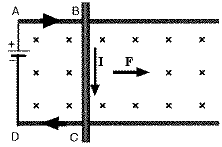
However, as the rod moves the flux through the area ABCD increases and Faraday's Law tells us an emf will be produced in that circuit. According to Lenz's Law, the direction of the induced emf will be such so as to oppose the increase in flux, i.e., the direction of the induced emf will be opposite to that from the battery. The net result is that as the rod accelerates, the rate of change of flux will increase and by Faraday's Law, so will the "back" emf; the result is the current in the circuit ABCD will be reduced. Eventually the "back" emf will become equal (but opposite) to the emf from the battery and then there will no current in the rod. With no current in the rod there will be no force and so no acceleration. In other words, the rod will continue to move at constant velocity; a sort of "terminal velocity" that depends on the strength of the magnetic field and the emf of the battery.
Answer [12]: A bolt of lightning is made up of rapidly moving charges; it is, therefore, a current, and we know a current has a magnetic field associated with it. However, the current in a bolt of lightning is erratic, it changes very rapidly. As a result, the magnetic field associated with it also changes very rapidly. The circuits in most household appliances, like radios and TV's, contain coils and so the magnetic flux through the coils from the lightning bolt will be time-dependent. This will result in an induced emf, i.e., an extraneous current, in the coils even though the appliance is not actually struck by the lightning.
Answer [13]: When the switch is closed a current will flow in the coil in the direction shown below:
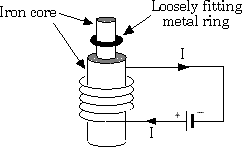
The right hand rule tells us the magnetic field lines associated with the current flow be directed downward from the bottom of the coil and inward at the top of the coil. As a result the bottom end of the coil acts like a north pole and the top end acts as a south pole. Also, the magnetic field lines pass through the metal ring.
In the short itme it takes for the current to rise from zero to a steady value after the switch is closed, the magnetic field associated with the current also rises from zero to a steady value. So, the flux through the metal ring changes; Faraday's and Lenz's Law tell us that an emf is induced in the metal ring, hence a current, whose direction is such that it opposes the change in flux. So, the field created by the induced current in tmetal ring will be directed upward through the ring, as shown below:
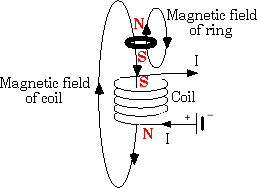
So, the metal ring "looks" like a magnet with a north pole above the ring and a south pole below. Consequently, there is a repulsive force between the top of the coil (south pole) and the bottom of the ring (also a south pole). Therefore, the ring will be "thrown" upward off the core.
If the polarity of the battery is reversed so the current now flows through the coil in the opposite dierction, the overall result is the same, i.e., the ring will again be "thrown" upward off the core because of repulsion between like poles. The diagram below indicates why:
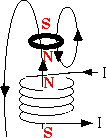
The only difference is that poles of the coil and ring are reversed, i.e., the north poles become south poles and the south poles become north poles.
So, it doesn't matter which way round the current is directed, the ring is always thrown upward. In fact, if the rate of change of current is large, the forces produced can be very large indeed and therefore dangerous if you get in the way! There has been some research into producing weapons using this technique.
Answer [14]: Actually, the answer is straightforward using no formulas! Since we can ignore any losses then according to energy conservation, the power in must equal the power out! So the power into any circuit connected to the secondary coils is the same in both cases.
If you want formula's let us consider one transformer with NP and NS turns on the primary and secondary coils, respectively. Then, according to the rules for transformers, the voltage from the secondary is:
and the current is:
Therefore the power in the secondary is:
= VP.IP.
Note that the result does not depend on NP nor NS, i.e., it holds for all transformers. So if the power input to two transformers is the same, then the power output from their secondary's must be the same also.
Answer [15]: As the ring falls down the magnetic flux passing through it changes and so emf's will be induced (by Faraday's Law). Since copper is a conductor then currents will be induced also. However, at points A and E there is no flux and so there is no change in flux; therefore no emf, and hence no current, is induced in the cooper ring at these points. Also, at C, there is flux through the ring it is not changing since the field is constant. So, no emf, hence no current, will be induced in the ring at C.
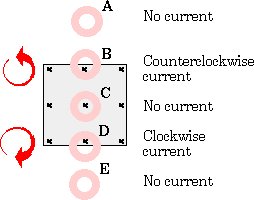
But at points B and D the flux through the ring is changing; at B the flux is increasing while at D it is decreasing. Therefore, Faraday's Law tells us that emf's, and currents, will be produced at those points. Lenz's Law tells us the direction of the induced currents will be such that they oppose the changes. So, at B the field induced by the current in the ring must be directed outward so, by the right hand rule, the induced current is counterclockwise. A similar argument tells us that the induced current at D must be clockwise.

If we look at the effect of the induced current we'll find an interesting effect. Remembering that the magnetic force acting on the charges (q) that are moving around the ring at B and D is
we note that the magnetic force acting on the ring is directed upwards at both B and D. As a result the magnetic force is a retarding force and so the acceleration of the ring is less than "g" at B and D. So, the ring slows down as it enters and leaves the field!
Note that if a plastic ring is dropped through emf's would be produced but there would be no induced current because plastic is an insulator.
Answer [16]: When a conductor carrying a current is placed in a magnetic field the field exerts a force on the conductor. After a moments thought you can understand that if eddy currents are flowing as shown below
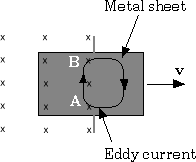
then the field exerts a force ONLY ON THE PART OF THE SHEET IN THE FIELD. There is no force on the right hand portion of the sheet because there is no field there. Now, think of the eddy current as going round a circuit and concentrate on the current along the line AB. By the right hand rule, the force on the current element AB is directed to the left, i.e., there is a retarding force against the motion. As a result, eddy currents tend to slow the sheet down.
In the arrangement below a metal sheet is moving from left to right through a region where there is a magnetic field (shaded). At points A, C and E there are no eddy currents because there is no change in flux through the sheet; at A and E the flux is zero and at C it is constant. However, whenever part of the sheet is out of the field eddy currents will be produced whose direction can be deduced from Lenz's Law, see the previous question. It turns out - and you can show this yourselves after looking at the previous question to figure out the direction the eddy currents - there will be retarding forces both at B and D.

In fact, this retarding effect is used in various devices as a brake to slow them down or to damp out unwanted motion.
Answer [17]: Consider the solid ring first. When the magnet is above the ring the magnetic field lines are directed downward throught the ring. As the magnet falls towards the ring, the flux increases and so an emf is induced in the ring, producing a current. Using either Faraday's or Lenz's Law we deduce that the direction of the current is as shown below (left).
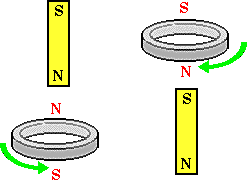
The induced current produces a field that by the right hand rule is directed upward so that the top of the coil acts like a north pole and the bottom of the coil acts like a south pole. Consequently, there is a repulsive force that tends to retard the downward motion of the magnet, so it slows down. After the magnet has fallen through the ring, the flux through the ring is still directed downward (toward the south pole of the magnet) but it is now decreasing. Using either Faraday's or Lenz's Law we deduce that the direction of the current is now as shown above (right). The induced fields now make the the bottom of the ring act like a north pole and the top, like a south pole. Now there is an attractive force between the south pole of the magnet and the bottom of the ring (a north pole). So, once again, the downward motion of the magnet is retarded.
When the ring has a gap in it, although emf's are produce by the changing flux, no currents (and hence no magnetic fields) are induced because the ring has infinite resistance. Consequently, the motion of the magnet is unaffected by the split ring. It's similar to what happens if a ring of plastic, i.e., an insulator, is used. So, if there's a race, the magnet falling through the split ring wins!
Answer [18]: In answers #15 and #16 above we saw that eddy currents are induced in a conductor when there is a change in flux. So, as the sheet enters the magnetic field (below left) a counterclockwise emf is induced, see the answers to #15 and #16 above. Also, as the sheet leaves the field, (below right) a clockwise emf is induced.
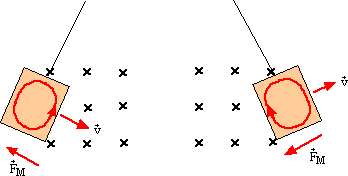
The magnetic forces acting on the sheet at these positions, due to the current, i.e., moving charges, is directed opposite to the motion. Therefore, there is a retarding force on the sheet at it enters and leaves the field that dampens, and eventually stops, the motion. So the interaction acts like a "brake". Of course, if the sheet is made of a non-conducting material, emf's are produced but there are no currents. Therefore, there is no magnetic retarding force.
The damping effect can be greatly reduced by cutting slots in the sheet as shown below (left).

The slots prevent the formation of large eddy current loops; in fact, as shown above (right) the paths induced currents that are perpendicular to the motion, run very close to each other and so the net retarding force acting on each metal segment as it enters (or leaves) the field is much reduced.
Now, with all this knowledge, can you predict what might happen with a metal "picture frame" and a metal mesh shown below?
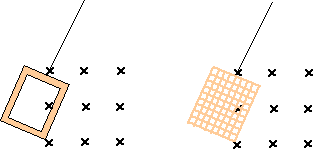
Answer [19]: The figure below shows the answer to this problem.

The current in coil 1, i1, produces a magnetic field that penetrates coil 2. The magnetic field will be proportional to i1, i.e., it will vary as sinωt) and the flux through coil 2, Φ2, will vary similarly. The induced emf in coil 2, ε2, is proportional to the negative of the rate of change of flux, i.e., its first derivative with respect to time. Accordingly, the variations of i1 and ε2 are shown in the plots above. So, you can see that the initiating current, i1, and the induced emf, ε2, are not in-phase; in fact, the emf and the current in coil 2 lead the current in coil 1 by one-quarter of a cycle, i.e., 90°.
If a sheet of metal, i.e., a conductor, is placed between the coils, the magnetic field penetrating coil 2 is modified, in fact, it is reduced. That results in a reduction in the induced emf (and current) in coil 2.
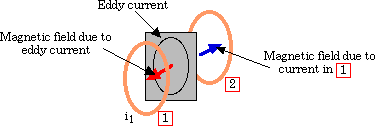
The reason is that eddy currents will be induced in the metal sheet that, themselves, produce a magnetic field. The direction of the field is given by Lenz's law, i.e., in a direction so as to oppose any change. For example, imagine that the current in coil 1 is increasing, then the magnetic field through the sheet, and through coil 2, is increasing also. Therefore, the eddy currents induced will create a magnetic field that opposes the increase, i.e., the eddy-current field is in the opposite direction to the initiating field. Magnetic fields add vectorially, so the net magnetic field through coil 2 is reduced. As a result, the emf induced in coil 2 will be reduced also. Note, that if a plastic sheet, i.e., a non-conductor, is inserted between the coils there are no eddy currents, no eddy-current magnetic field and so the emf induced in coil 2 doesn't change!
In fact, this idea is the basis of "walk-through" metal detectors. If you walk between a transmitting coil carrying an alternating current, coil 1, and you have a metal object on you, the emf induced in the detector coil, coil 2 will be reduced. This drop in emf (and the current in the circuit) can be readily detected and alarm bells will sound! Of course, any non-conducting material between the coils, like clothing, plastic, leather, etc., has no effect on the emf.
Answer [20]: Aha! Basically, an electric motor consists of a current carrying coil located in a magnetic field. An input current through the coil produces a magnetic moment (μ, so the coil experiences a torque (τ = μ × B) in the magnetic field (B) that causes it to rotate. However, because the coil is rotating (and turns the fan blades) Lenz's Law comes into play! An emf (and current) is induced in the coil by the changing flux that opposes the input current; as a result, the net current flowing in the coil is the input current minus the induced current. If you stop the blades, then there is no induced current, so the current flowing in the coil increases. That latter current may well be enough to dissipate sufficient power to "burn out" the wire in the coil in a short time.
Note that immediately the fan is switched on, the current in the coil is at its maximum. As the fan "speeds up", the induced current increases and so the net current decreases. When you pay for electric power, you are effectively paying for the net current and so the cost to "run" the fan is greatest at switch-on but it reduces to a steady, lower cost, when the fan is operating at normal speed.
Answer [21]: The answers can be obtained using the equation for the inductance of a solenoid:
where n is the number of turns per unit length, A is the area and L the length.